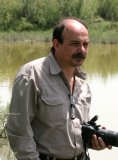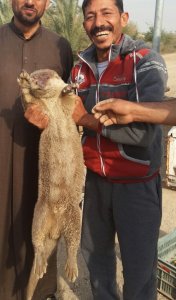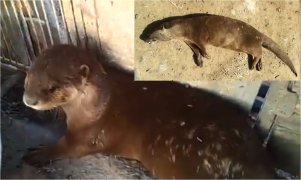IUCN/SSC Otter Specialist Group Bulletin

|
©IUCN/SCC Otter Specialist Group Volume 32 Issue 1 (January 2015) Citation: Al-Sheikhly, OF, Haba, MK, and Barbanera, F (2015). Recent Sighting Of Smooth-Coated Otter Lutrogale perspicillata maxwelli In Hawizeh Marsh (Southern Iraq) . IUCN Otter Spec. Group Bull. 32 (1): 30 - 32 Recent Sighting of Smooth-Coated Otter Lutrogale perspicillata maxwelli in Hawizeh Marsh (Southern Iraq) Omar F. Al-Sheikhly1,Mukhtar K. Haba2 and Filippo Barbanera3 1Department of Biology, University of Baghdad, Iraq. +964 7901 7890 24
Email: alsheikhlyomar@gmail.com |



|
| Abstract: Since 1956, there were very few sightings of Iraq Smooth-coated Otter (Lutrogale perspicillata maxwelli) especially after the Iraqi marshlands inundation. In April 2015, male Iraq Smooth-coated Otter was trapped near Al-Edheam, in the northern part of Hawizeh Marsh (Southern Iraq). The recent sighting along with present photographic record represents very rare evidence documenting the occurrence of L. p. maxwelli otter in Iraq since the 1950s. |
| Française | Español | Arabic |
In 1956, the Iraq Smooth-coated Otter was described by Hayman as a distinct taxon (Lutrogale perspicillata maxwelli) on the basis of a skin from a dead individual and a six weeks old male otter named “Mjbil”. The latter was brought to G. Young Maxwell by Marsh Arabs from a tumulus island village called Daub to the North West of Al-Azair in Hawizeh Marsh (Al-Sheikhly and Nader, 2013; Al-Sheikhly et al., 2014). The newly discovered otter was referred to as Smooth-coated Otter because of both its fur and tail, which were darker and flatter than in the European Otter Lutra lutra (Hayman, 1956; Young, 1977). However, the world knew “Mijbil” only from a very few photographs where it was featured with his master G.Y. Maxwell (Maxwell, 1959; 1960). Since then, limited information and photographs concerning this mysterious subspecies were available. For decades, “maxwelli” was just a ghost roaming the reed beds of southern Iraqi marshes.
During 1990s, the Iraqi marshes were drained by the previous regime for political reasons and a tragic decline in the marshes biota had occurred. The endemic-to-Iraq Smooth-coated Otter became very rare after marshlands inundation in 2003 and since then its population faced a dramatic decrease in size due to hunting, trapping, and habitat destruction (Al-Sheikhly and Nader, 2013).
Very recently (April 29th, 2015), local hunters trapped adult male L. p. maxwelli near Al-Edheam Marsh, in the northern part of Hawizeh Marsh (31°40'N, 47°45'E) (southeastern Iraq) (Fig. 1). Interviewed people informed us that the otter survived for a while before it died due to both bad trapping techniques and the stress experienced when it was moved from the marsh to nearby urban area. Present photographic record represents valuable yet very rare evidence documenting the occurrence of L. p. maxwelli otter in Iraq since the 1950s.
Otters’ hunting and trapping are not merely historical activities in Iraq, as both Smooth-coated and European Otter are still targeted in the marshes (Fig.2). Indeed, we noted such practices during recent field surveys carried out in southern Iraqi marshes (see Acknowledgments). Furthermore, the conflict between otters and anglers as well as habitat degradation and fragmentation is ongoing with marked effects particularly on the Smooth-coated Otter population (Al-Sheikhly et al., 2014). Recent hunting incident herein reported emphasizes the need for urgent conservation actions to protect this endemic taxon in Iraq. Otherwise, both hunting and trapping along with habitat loss will drag maxwelli otter to the edge of extinction.

|
| Figure 2. Large Lutra lutra male recently hunted by a local angler in the Iraqi marshes (Photo: Kamel Al-Batat, 2015). (click for larger version) |
Acknowledgements - Authors are grateful to the National Geographic Society Conservation Trust (Washington, USA) for granting (#C261-13 to F. B.) a conservation research project on the Smooth-coated Otter including fieldwork in the Mesopotamian marshes. We would like to thank Mr. Kamel Al-Batat, Mr. Ahmad S. Al-Hassnawi,Mr. Abass Al-Ghanami, and Mr. Raheem Al-Ghanami for providing photographs of otters’ hunting in the Iraqi marshes.
REFERENCES
Al-Sheikhly, O.F., Nader, I.A. (2013). The status of Iraq smooth-coated otter Lutrogale perspicillata maxwelli Hayman 1956 and Eurasian otter Lutra lutra Linnaeus 1758 in Iraq. IUCN Otter Specialist Group Bulletin 30: 18-30.
Al-Sheikhly, O.F., Haba, M.K., Barbanera, F. (2014). Otter hunting and trapping, a traditional practice of Marsh Arabs of Iraq. IUCN Otter Specialist Group Bulletin 31(2): 80-88.
Hayman, R.W. (1956). A new race of the Indian smooth-coated otter from Iraq. Annals and Magazine of Natural History Series 12(9): 710-712.
Maxwell, G.Y. (1959). A reed shaken by the wind; a journey through the unexplored marshlands of Iraq. Penguin, Harmondsworth. 223 pp.
Maxwell, G.Y. (1960). Ring of bright water. Longman's Green and Co. Pub. London. 211pp.
Young, G. (1977). Return to the marshes: Life with the Marsh Arabs of Iraq. Collins St. James's Place, London, Hutchinson.
Résumé : Recente Observation de la Loutre à Pelage Lisse Lutrogale perspicillata maxwelli dans les Marais de Hawizeh (Sud de l'Irak)
Depuis 1956, il y a eu très peu d'observations de la Loutre à pelage lisse d'Irak (Lutrogale perspicillata maxwelli) et cela spécialement après l'inondation des marais Irakiens. En avril 2015, un mâle adulte de Loutre à pelage lisse d'Irak a été capturé à proximité d'Al-Edheam dans la partie nord du marais de Hawizeh (Sud de l'Irak). Cette récente observation conjointe avec la présente photo ci-dessus constitue une preuve extrêmement rare révélant la présence de la Loutre L. p. maxwelli en Irak depuis les années 50.
Revenez au dessus
Resumen: Avistamiento Reciente de Nutria Lisa Lutrogale perspicillata maxwelli en el Pantano Hawizeh (Sur de Iraq)
Desde 1956, han habido muy pocos avistamientos de la Nutria Lisa de Iraq ( Lutrogale perspicillata maxwelli), especialmente después de la inundación de los pantanos Iraquíes. En Abril de 2015, fue trampeado un macho adulto de la Nutria Lisa Iraquí, cerca de Al-Edheam, en la parte norte del Pantano Hawizeh (Sur de Iraq). Este avistamiento reciente, junto con el registro fotográfico, representa una muy rara evidencia que documenta la ocurrencia de la nutria L.p. maxwelli en Iraq desde los 1950s.
Vuelva a la tapa

